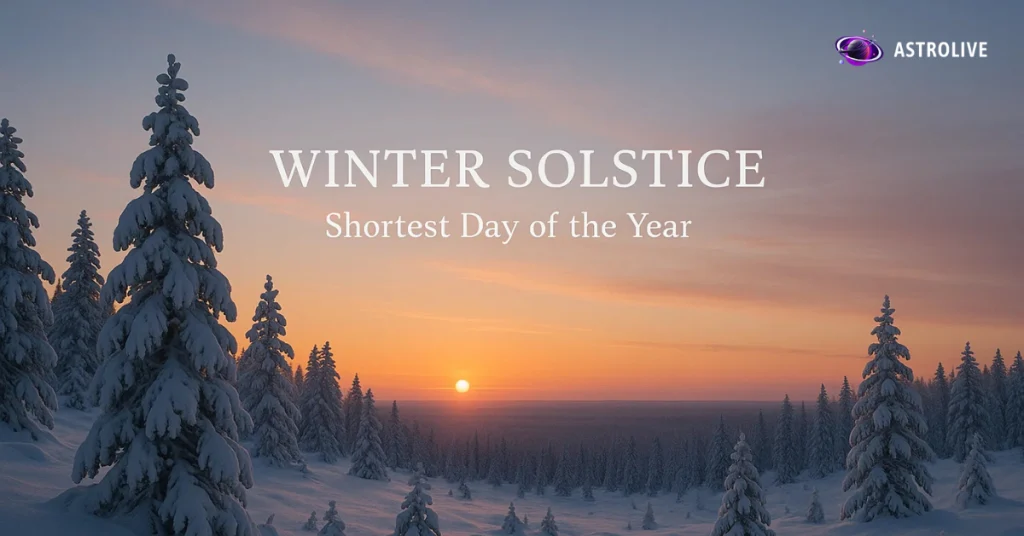As the calendar flips toward the end of December, the northern hemisphere braces for one of the most fascinating celestial events of the year — the shortest day of the year. Known for centuries, this day marks the point when sunlight is at its minimum, leaving us with the longest night and the briefest day. But what exactly happens on this unique day, why does it occur, and how do people across the world celebrate it? Let’s dive into the captivating world of the winter solstice 2025 and uncover the secrets of this day of the year.
What Is the Shortest Day of the Year?
When people ask, “what is the shortest day of the year?”, they’re referring to a day when the Sun takes the shortest path across the sky. Simply put, it’s the day with the fewest hours of daylight. For the northern hemisphere, this usually falls around December 21st or 22nd. In 2025, the shortest day 2025 is expected to occur on December 21st, coinciding with the winter solstice 2025.
The term “winter solstice” comes from the Latin words sol (Sun) and sistere (to stand still). During the solstice, the Sun appears to pause in its southward journey before reversing direction. This phenomenon is the natural reason behind our shortest day of the year and the longest night.
Why Does the Shortest Day Happen?

The Earth’s axis is tilted at approximately 23.5 degrees relative to its orbit around the Sun. This tilt causes the variation in daylight hours throughout the year. During the winter solstice, the North Pole tilts farthest away from the Sun, meaning sunlight reaches the northern hemisphere at its most oblique angle.
This tilt is why the Sun rises later and sets earlier than any other day of the year. While we might only get around 8–9 hours of daylight in northern regions, southern hemisphere countries experience their longest day of the year — a fascinating contrast that underscores the complexity of Earth’s relationship with the Sun.
When Is the Shortest Day of the Year?

For many, knowing when is the shortest day of the year is more than a curiosity—it helps plan winter activities, festivals, and even seasonal traditions. In 2025, the winter solstice will fall on Sunday, December 21st. Mark your calendars because this day brings both astronomical significance and cultural celebrations worldwide.
It’s worth noting that while the solstice is the astronomical event, the exact duration of daylight can vary depending on your location. Northern cities closer to the Arctic Circle might see just a few hours of sunlight, while cities near the equator experience less variation throughout the year.

How the Shortest Day Affects Nature?
The shortest day of the year isn’t just about human schedules—it impacts the natural world in profound ways. Animals, plants, and even weather patterns respond to these shifting daylight hours.
- Plants: Reduced daylight triggers dormancy in many plant species. Trees shed leaves, and flowers slow their growth, conserving energy for the longer days ahead.
- Animals: Many animals adjust their behavior and metabolism in response to shorter days. Some hibernate, like bears, while others alter migration patterns.
- Weather Patterns: With shorter sunlight exposure, temperatures drop in many regions, often marking the coldest period of winter.
Understanding these changes gives us a glimpse into how interconnected life on Earth is with the movements of the Sun.
Cultural Significance of the Winter Solstice
The winter solstice 2025 is not just a scientific marvel—it carries centuries of cultural and spiritual significance. Across the globe, civilizations have celebrated this day with rituals, festivals, and traditions.
- Ancient Europe: Stonehenge in England aligns with the sunrise on the winter solstice. Early communities likely gathered to observe this moment, honoring the rebirth of the Sun.
- Scandinavia: The Norse celebrated Yule, lighting fires to invite warmth and sunlight back into the world. This tradition is considered a precursor to modern Christmas customs.
- Asia: In China, the Dongzhi Festival marks the arrival of winter with family gatherings and special foods like dumplings and glutinous rice balls.
- Americas: Indigenous peoples, including the Pueblo and Hopi tribes, held ceremonies to honor the Sun’s journey, emphasizing renewal and hope.
Many cultures see the shortest day as a time for reflection and renewal. Platforms like AstroLive provide guidance on how celestial events like the winter solstice might influence personal energies, helping you plan rituals or personal observances in alignment with the cosmos.
Explore the Winter Solstice with AstroLive

Curious how the shortest day of the year might influence your personal energy or decisions? AstroLive connects you with authentic astrologers live, offering guidance on everything from tarot readings to Vedic astrology. With experts available in Hindi, English, and regional languages, you can get insights tailored to your life—anytime, anywhere.
- First Consultation Free: Download the app via Apple Store or Google Play.
- Live Chat with Astrologers: Instant guidance at ₹10–₹22/min.
- Daily Horoscope & Panchang: Stay updated with cosmic timings and predictions.
- Free Kundli & Matchmaking: Personalized charts and compatibility insights.
Users love AstroLive for its easy-to-use app and expert astrologers—perfect for celebrating the winter solstice.
Fun Facts About the Shortest Day
The shortest day of the year is full of interesting surprises:
- Longest Night: On this day, the night can last up to 16 hours in some northern regions.
- Sunrise & Sunset: The Sun rises the latest and sets the earliest — though the exact times can differ based on location.
- A Turning Point: After the solstice, daylight gradually increases, signaling the slow return of warmer, lighter days.
- Global Perspective: While the northern hemisphere experiences its shortest day, the southern hemisphere enjoys its longest day of the year, highlighting the balance of our planet’s tilt and orbit.
These facts remind us that the shortest day of the year is not just a static event but part of a dynamic rhythm of nature.
Observing the Winter Solstice
Whether you’re a casual sky-gazer or an avid astronomer, there are several ways to observe and celebrate the winter solstice 2025:
- Sunrise & Sunset Watching: Find a clear horizon and watch the Sun take its shallowest path across the sky.
- Cultural Rituals: Try incorporating elements of ancient traditions, like lighting candles or gathering with friends and family.
- Astronomical Activities: Use telescopes, apps, or star charts to track the Sun’s position and the changing length of daylight.
- Nature Walks: Observe how animals and plants respond to the seasonal shift, offering a real-world connection to this celestial event.
Whether you’re watching the sunrise, performing rituals, or reflecting on seasonal changes, astrology can guide your important decisions. For instance, you can check How To Choose The Best Marriage Dates For A Perfect Wedding? to align life events with cosmic timings.
The Science Behind the Date
Many people wonder, “when is the winter solstice?” or why the date seems to change slightly each year. This variation happens because Earth’s orbit is not a perfect 365 days—it takes about 365.24 days for the planet to complete one orbit around the Sun. This extra fraction is why we have leap years and why the solstice can fall on December 20th, 21st, or 22nd.
For 2025, astronomical calculations pinpoint December 21st as the precise moment of the solstice. Scientists use observations of Earth’s tilt and orbit to predict not just the solstice, but the exact times of sunrise, sunset, and the duration of daylight worldwide.
Shortest Day Around the World
Different regions experience the shortest day of the year differently:
- Arctic Circle: Some areas have polar night, where the Sun doesn’t rise at all.
- Northern Europe & North America: Around 8–9 hours of daylight.
- Equator: Daylight remains roughly 12 hours, with minimal variation throughout the year.
- Southern Hemisphere: This is the longest day of the year, showcasing the mirrored experience across the globe.
This variation highlights how latitude and the Earth’s tilt shape our experience of time and light.
Read More: –
How To Choose The Best Marriage Dates For A Perfect Wedding?
Myths and Legends
Throughout history, the shortest day of the year and winter solstice have inspired myths, legends, and spiritual beliefs:
- Sun Gods and Rebirth: Ancient civilizations believed the Sun’s apparent “pause” heralded a period of rebirth, renewal, and hope.
- Fertility Rituals: Some cultures performed rituals to ensure the return of life and abundance in the coming spring.
- Warding Off Darkness: Fire, light, and celebration were used to combat the metaphorical and literal darkness of the season.
These stories reflect humanity’s enduring fascination with light, time, and our connection to the cosmos.
Winter Solstice in 2025: What to Expect
Looking forward to winter solstice 2025, people can expect:
- The shortest day of 2025 will be December 21st.
- Northern hemisphere locations will experience long nights and brief daylight.
- Weather patterns might bring colder temperatures, frost, or snow depending on your region.
- Globally, cultural events and festivals will mark this celestial milestone.
Being aware of the solstice allows us to plan celebrations, appreciate nature, and reflect on the rhythms that govern life on Earth.
Tips to Make the Most of the Shortest Day
- Embrace the Darkness: Take a quiet walk, meditate, or stargaze to appreciate the beauty of longer nights.
- Celebrate Light: Light candles, set up small fires, or create a cozy environment at home to honor the Sun’s journey.
- Connect with Nature: Observe how plants and animals respond to shorter daylight hours — it’s a live lesson in seasonal adaptation.
- Learn & Reflect: Read about the astronomical significance, cultural traditions, and myths tied to the shortest day of the year.
If you want a deeper connection with the sky’s movements and how they might relate to your personal life, AstroLive offers live readings and celestial insights to complement your solstice experience.
Conclusion
The shortest day of the year is far more than just a date on the calendar. It’s a reminder of the intricate dance between Earth and the Sun, the wonders of seasonal change, and humanity’s enduring fascination with the cosmos. By knowing when is the shortest day of the year, observing the winter solstice 2025, and appreciating the natural and cultural significance, we can turn this fleeting moment of light into a celebration of life, nature, and time itself.
So, mark December 21st, 2025 on your calendar, step outside, and witness the Sun’s shallowest path across the sky. After all, the shortest day of the year is also a day full of meaning, history, and beauty — a day to reflect, celebrate, and look forward to the returning light.
Frequently Asked Questions (FAQ): –
1. What is the shortest day of the year called?
The shortest day of the year is known as the winter solstice. It’s the day when the Sun travels its lowest and shortest path across the sky, resulting in the least amount of daylight for the northern hemisphere.
2. When is the shortest day of the year 2025?
The shortest day of the year 2025 will occur on Sunday, December 21st. This marks the winter solstice 2025, the astronomical event when the northern hemisphere is tilted farthest away from the Sun.
3. Why does the shortest day of the year happen?
It happens due to Earth’s axial tilt of about 23.5 degrees. During the winter solstice, the North Pole leans farthest from the Sun, making daylight hours shorter and nights longer.
4. How long is the shortest day of the year?
The exact length varies depending on where you live. In northern regions, daylight may last only about 8 hours or less, while closer to the equator, the difference is minimal — around 11 to 12 hours of daylight.
5. What happens after the winter solstice?
After the winter solstice, daylight gradually begins to increase each day. This shift signals the slow return of longer, brighter days, eventually leading to spring.







